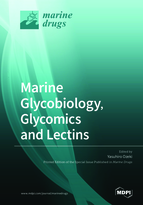Marine Glycobiology, Glycomics and Lectins
A special issue of Marine Drugs (ISSN 1660-3397).
Deadline for manuscript submissions: closed (31 July 2019) | Viewed by 56190
Special Issue Editor
Interests: glycobiology; lectins; marine invertebrates
Special Issues, Collections and Topics in MDPI journals
Special Issue Information
Dear Colleagues,
Glycans (carbohydrate chains) of marine creatures are rich and diverse in glycoproteins and glycolipids, and also glycan-related enzymes (glycosyltransferases and glycosidases). They are recognized by themselves (carbohydrate-carbohydrate interaction), and/or by lectins (glycan-binding proteins), which regulate comprehensive cellular manners such as growth, differentiation and death. These views lead us to combine the subjects for both marine life systems and human diseases. Standing on the background of glycan-based biosciences (glycobiology), this Special Issue, "Marine Glycobiology, Glycomics and Lectins", welcomes your articles and reviews. Marine glycomics that involves the glycoproteome and transcriptome accelerates our understanding of evolution of glycans, glycan-related enzymes and lectins. Glycomics also promotes the application of marine glycobiology to discover novel biomaterials which contribute to drug development. Lastly, as a useful resource, there are many kinds of lectins, which have versatile glycan-binding specificities and can decipher the codes of diverse glycan structures. They have strong potential to be applicable to medicine and diagnostics for regeneration and/or cancer therapy in the future.
Prof. Yasuhiro Ozeki
Guest Editor
Manuscript Submission Information
Manuscripts should be submitted online at www.mdpi.com by registering and logging in to this website. Once you are registered, click here to go to the submission form. Manuscripts can be submitted until the deadline. All submissions that pass pre-check are peer-reviewed. Accepted papers will be published continuously in the journal (as soon as accepted) and will be listed together on the special issue website. Research articles, review articles as well as short communications are invited. For planned papers, a title and short abstract (about 100 words) can be sent to the Editorial Office for announcement on this website.
Submitted manuscripts should not have been published previously, nor be under consideration for publication elsewhere (except conference proceedings papers). All manuscripts are thoroughly refereed through a single-blind peer-review process. A guide for authors and other relevant information for submission of manuscripts is available on the Instructions for Authors page. Marine Drugs is an international peer-reviewed open access monthly journal published by MDPI.
Please visit the Instructions for Authors page before submitting a manuscript. The Article Processing Charge (APC) for publication in this open access journal is 2900 CHF (Swiss Francs). Submitted papers should be well formatted and use good English. Authors may use MDPI's English editing service prior to publication or during author revisions.
Keywords
-
Carbohydrate-carbohydrate interaction
-
Protein-carbohydrate interaction
-
Marine lectins
-
Structural glycobiology
-
Glycoproteome
-
Transcriptome
-
Glycomicrbiology
-
Glycosphingolipids
-
Glycosaminoglycans
-
Marine glycomedicine







